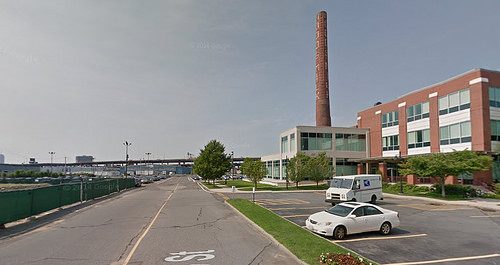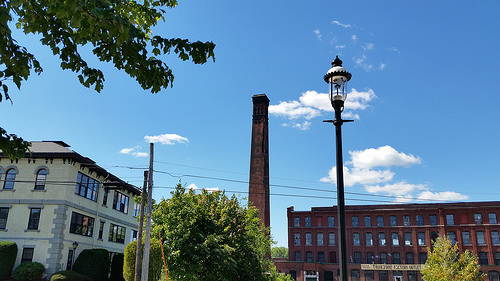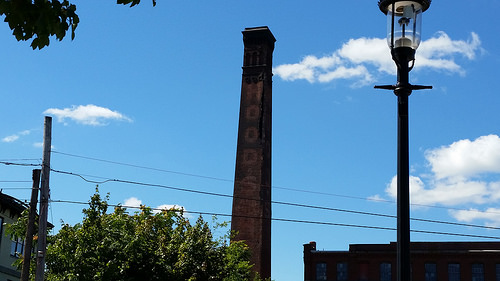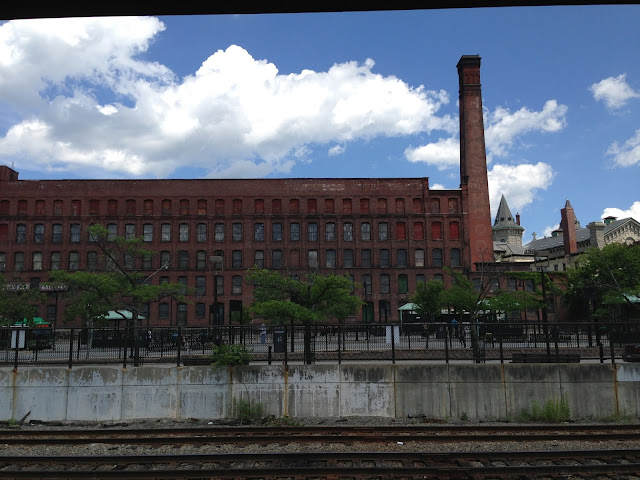John Keohane probably started working in Ireland as a laborer even before he finished school - families were poor and sons needed to help support them as soon as they were able to get a job. He likely worked around the Poor Law Union of Kinsale - maybe with his father. Some time before he emigrated to Boston, he arranged to get a house for his father and family. There might have been an American Wake before he headed for Queenstown. He boarded the SS Laconia on the same day that the Titanic would strike the iceberg. His ship docked in Boston 11 days later, and John Keohane made his way to Lowell.
But what happened then? Did Denis Crowley have a job for him? Did John Keohane go out looking for work? I couldn't find him in any Lowell City Directories. Family lore was that he worked in Lowell and then made his way to Belmont.
I was ecstatic when I started researching Tom Keohane and received some information from Frances Keohane Smith and her son Kevin! Page 2 Line 7 on her father's passenger listing on the SS Cymric states that he is joining his brother John Keohane at Hood Farm in Lowell!! This is it! This is where my grandfather has been working!
But where the heck is Hood Farm in Lowell? I did some internet searching and contacted Memorial Hall Library in Lowell.
The Merrimack Valley Library Consortium kindly responded to my questions.
"Re: Hood Farm From:
Hood's Farm was in Tewksbury. Here is the email for the Tewksbury Historical Society
tewksburyhistoricalsociety@msn.com
----- Original Message -----
From: Reference Desk
To: sfougstedt@mvlc.org
Sent: Friday, September 09, 2011 8:40 AM Subject: Fw: Hood Farm
----- Original Message -----
From: Mary Ellen Murphy
To: mloref@mvlc.org
Sent: Friday, September 09, 2011 12:36 AM Subject: Hood Farm
Good evening,
I wondered if you knew the location of CI Hood's farm - he manufactured sarsaparilla in downtown Lowell and had a farm on the outskirts of Lowell. If you do not have the information, could you suggest where I might find it?
Thank you very much,
Mary Ellen Murphy
Falmouth, Mass.
irishmomma4@yahoo.com
I checked the website - https://baybottles.com/2017/01/30/hoods-tooth-powder-c-i-hood-co-lowell-mass/ - which explains that:
"C.I. stands for Charles Ira Hood. C.I. Hood & Co., whose signature product was Hood’s Sarsaparilla, was in business from the early 1870’s through 1922. Hood’s story, as well as the early history of the company, was told in “America’s Successful Men of Affairs: The United States at Large by Henry Hall, New York Tribune, 1896:
"The Lowell Mass. City Directories generally corroborate the story. C.I. Hood & Co., apothecaries, was first listed in the 1872 Directory, located at Merrimack, corner of Central. By 1880, in addition to the Merrimack location, he also listed a laboratory located on Church, near the Concord River. Then in 1881, the company location was changed to “Thorndike, near the jail.”
I checked www.ancestry.com for a listing in the 1912 Lowell directory for Charles I Hood - the year John Keohane arrived in Lowell, but nothing came up. I did find him listed in 1913 as president, treasurer, and general manager of CI Hood Co, house at 436 Andover Street.
His company is listed on the next line as CI Hood Company, manufacturing chemists, Hood's Sarsaparilla & laboratory, Thorndike (Street) near the jail, telephones 1660 and 1661(see page 890.)
"Hood’s Sarsaparilla, Lowell, MA
Founded by Charles Ira Hood in 1875, C.I. Hood & Co. of Lowell, Massachusetts was among the largest patent medicine companies in the United States and offered a number of personal health products in addition to its well known Hood’s Sarsaparilla. The C.I. Hood and Company was a leader in the development of color lithography as an advertising tool, and produced all of its advertising in-house and owned twenty presses issuing a plethora of colorful trade cards, posters, calendars, cookbooks, pamphlets, and other ephemera all promoting the medicinal benefits of company products.
According to Richard Howe, In 1876, Charles followed the lead of J.C. Ayer & Company and began to compound his own sarsaparilla medicine. In addition to sarsaparilla root, he mixed in dandelion, gentian, juniper berries and 18% alcohol. He claimed great success in curing a variety of disorders including “purifying the blood”, heart diseases, dropsy, rheumatism and scrofula ( a form of tuberculosis that occurs outside the lungs). Within two years of launching his product he was on his way to great success. Charles Hood added to his success with Hood’s Tooth Powder, Vegetable Pills, Oil Ointment, Medicated Soap, Dyspeplets (for dyspepsia), TusSamo (for cough) and Hood’s Lotion.
Business was so brisk that Charles Hood needed a larger space. In 1882, he built the four-story Hood’s Laboratories on Thorndike Street, close to the Boston & Lowell railroad depot. He enlarged the laboratories in 1892 and 1897, giving him 175,000 square feet devoted to the manufacture and sale of patent medicines. The first floor was used for storage and freight shipments. The railroad station was easily reached through the back door. The second floor had the advertising and printing offices. All advertising was done on the premises. Here Hood’s printed its calendars, lithographic trade cards and cookbooks. In 1879, seventy million pieces were printed and delivered from these offices. C.I. Hood was the largest single user of the U.S. Mail in Lowell. In addition, C.I. Hood advertisements regularly appeared in newspapers coast to coast. The third floor had the counting room, boiling area and the automatic bottle filler, capable in 1884, of filling 10, 000 bottles a day, and more in later years. The fourth floor held the giant tanks, capable of filling 240,000 bottles.”
Following his death in 1922, the C.I. Hood & Co. business was sold by his widow."
The following 2 pictures are the front and back of a trading card about Hood's plant.
Below are Charles I Hood's own words describing the start of his business that I found on http://www.cliffhoyt.com/cihood.htm. Look at the range of conditions that can be treated with Sarsaparilla!
In 1917, Mr. Hood reminisced about the beginnings of his company:
"Forty-two years ago, after ten years of apprenticeship and ownership in an apothecary store, it occurred to me that there was a great opportunity for a business introducing a blood-purifying medicine with efficiency and economy as its base.
"With the ambition and exuberance of young manhood I earnestly determined to make this idea a livewire.
"Fortunately, just at this time, a patient ... brought to my drug store a prescription of unusual ingredients, which produced a remarkable cure for this customer, who had been a great sufferer from blood and nerve troubles ... for several years...
"I took this prescription as a base and perfected a formula for Hood's Sarsaparilla. The sale of this medicine surpassed all my expectations and made the name of Hood known in every city, town, and village in this country and also widely abroad."
Mr. Hood felt that the success of his medicine was due to his care in analysis and experiments conducted with "all the knowledge which modern research in medical science had developed." Taking the successful prescription, he added other well-known vegetable remedies. The result included the following ingredients:
● SARSAPARILLA ROOT--of great service for skin disorders, rheumatism, dropsy, and diseases of a scrofulous origin. (Scrofula is an enlargement of the lymph glands, with abscesses. It originates from tuberculosis. Many problems were due to a scrofulous condition of the blood.)
● UVA URSI--much needed by sufferers from kidney complaints, inflammation of the bladder, chronic diarrhea, diabetes, and troubles of a more delicate nature in either sex.
● BLUE FLAG--especially recommended for scrofula, syphilis, glandular tumors, rheumatism, dyspepsia, constipation, and certain private diseases.
● YELLOW DOCK--remarkable in its effect against scorbutic, cutaneous, scrofulous scirrhous, and syphilitic affections.
● DANDELION--A sign of hope for torpid liver, jaundice, depression, and melancholia.
● GENTIAN--useful for dyspepsia, loss of appetite, exhaustion, gout, and hysteria.
● MANDRAKE--without equal for constipation, scrofula, and skin diseases.
● JUNIPER BERRIES--relieve suffering due to catarrh of the bladder, kidney complaint, and diseases of the urinary organs.
● PIPSISSEWA (Wintergreen)--eminently useful for diseases of the blood, eczema, eruptions, rheumatism, gout, dropsy, and catarrh of the bladder.
● STILLINGIA--eradicates pimples, boils, abscesses, ulcers, syphilis, and chronic bronchitis.
● ALCOHOL (18%)--If the other ingredients didn't cure you, at least you wouldn't feel any pain."
Below are advertisements for Hood's Sarsaparilla.
So Charles I Hood made a fortune with his Hood's Sarsaparilla and his other "medications."
As a quick aside - I was always curious if Hood Milk Company had any relation to C.I. Hood's Sarsaparilla. Hood Milk used to be delivered by a milkman to your door, and Hood Ice Cream is sold in supermarkets. I just found this article on the Lowell Historical Society's web page:https://www.lowellhistoricalsociety.org/a-tale-of-two-hood-smokestacks/
"A Tale of Two (Hood) Smokestacks
September 8, 2014 by DickH
Thanks to Eileen Loucraft for sharing the following about the Hood Smokestack on Thorndike Street that was damaged by lightning over the weekend:
Since the lightning strike in Lowell last night damaging the Hood smokestack on Thorndike Street at the former C.I. Hood patent medicine plant I thought I’d explain the connection with the Hood Milk smokestack in Charlestown, MA.

"Harvey Perley Hood was born in Chelsea, Vermont on January 6, 1823. He founded Hood Dairy in Charlestown, MA and expanded throughout New England. The family sold the company some years ago. The Hood Milk smokestack in Charlestown can be seen by all who drive into Boston from Route 93. It is quite noticeable right before the Bunker Hill Monument. New Englanders have been buying Hood dairy products for years (milk, cream, ice cream and Hoodsie cups).
Charles Ira Hood was born in Chelsea, Vermont December 11, 1845. He founded Hood Laboratories and moved to Thorndike street in 1883. He made patent medicines sarsaparilla, tooth powder and lots of advertising. He also had a large farm in North Tewksbury where he raised award winning Jersey cows. Anyone coming into Lowell via the Lowell Connector and taking the Thorndike Street exit will notice the 100 foot smokestack. He was married and lived on Andover Street but did not have any children.
Seeing that they were both born in Chelsea Vermont seemed to be too big of a coincidence. Come to find out they are second cousins as their grandfathers are brothers. The Hood family can be traced back to early America and even the Salem witch trials."


The above article leads us to Hood Farm where John and Tom Keohane worked. We don't know if Dennis Crowley got John Keohane a job or if he hunted it down himself. But there was a neighbor, Jeremiah Keohane, living at 204 Moore Street and working at CI Hood in the 1912 Lowell City Directory. I found him when I was looking for our John Keohane in that directory.
So I went back to the 1910 US Census of Lowell to see if this Jeremiah was listed there - and he was! He is living at 204 Moore Street. Andrews Street - where Dennis Crowley lived - runs off Moore Street. Jeremiah is 37 years old - born in Ireland - he emigrated in 1898 and is a naturalized citizen - he works as a herdsman on a farm. It looks like he may have a mortgage on the house. His wife Mary is 30 years old and was born in Illinois! They have been married for 2 years and have one child - a son Micheal who is 2 months old.
It is quite interesting that Jeremiah is a herdsman. So I checked for a 1910 Lowell City Directory and found him again listed as working at CI Hood - so he must work on Hood's farm! So did he know Dennis Crowley and John Keohane? Keohane is an unusual Irish name - was he related to John Keohane?
I thought perhaps his parents' names and location in Ireland might be on his marriage registration. So I did a search on Ancestry - there were quite a few Jeremiah Keohanes and Jeremiah Cohans in Massachusetts. I did find a Jeremiah Keohane - age 36 - who married Mary Bane on 27 January 1909 in Jerseyville, Jersey, Illinois. There was no other information and no copy of the marriage registration. The dates aren't an exact match but pretty close compared to others I found. I couldn't find any passenger listings, naturalization, or death records that seemed to be a match for Jeremiah although I found plenty of them. So perhaps we will never know if he was related or not to John Keohane, but my best guess is that he knew John Keohane because he lived close by and they probably attended the same church.
But whether Jeremiah got my grandfather a job at Hood Farm or not, John Keohane found a job there where they certainly must have worked together. Which leads me to ask if they commuted to the farm and if they did, how did they get there? Or were there quarters on the farm for the employees?
The following December 2014 article tells us a little more about Hood Farm. It is by Jim Batchelder of the Andover Historical Society.
"From: web1@mhl.org [web1@mhl.org] Sent: Friday, June 07, 2013 11:19 PM To: Ref Desk
Subject: Reference Question
Reference Question
Email address Name: Town/State: Daytime phone: Evening phone: FAX:
Question:
irishmomma4@yahoo.com
Mary Ellen Murphy East Falmouth, Ma 617-458-1247 617-458-1247
Hello,
Are these the articles you are referring too?
Hood Farm stood on River Road, stretching hundreds of acres from north Tewksbury to West Andover. It included Jersey stock and Berkshire swine. In 1922, Hood Farm closed due to Charles Hood's failing health. The Friars of St. Francis purchased the farmhouse.
See
"Past and Present: Hood Farm and the St. Francis Seraphic Seminary," (photo) Andover Townsman, May 15, 2003.
"Hood memories," Andover Townsman, June 19, 2003.
If so I can email them to you via our microfilm reader. If there are other articles you know of please tell me those as well and I can send them too!
Thank you,
Clare
Information Services Department Memorial Hall Library
2 North Main Street
Andover, MA 01810 978-623-8401 x31 or x32 www.mhl.org"
To: Ref Desk
Subject: Re: Reference Question
Hi Clare,
These are the articles. Please let me know how much it would cost to email these to me. I would really appreciate it.
I was actually in Lowell yesterday - my son teaches history at LHS and he drove over to River Road - we saw the area where the farm probably stood altho we couldn't fathom what hundreds of acres would be. We saw Hood Street or Hood Road so we figured we were in the right area - also Bailey Road/Street - I think I saw Bailey mentioned in an address.
My grandfather worked at Hood Farm for several years when he came out from Ireland to Lowell in 1912. Now that I have two sons living in Lowell, we were interested in finding out about it.
Thanks so much! I live on Cape Cod and don't get to Lowell too often. I thought I might get to your library yesterday on the way home but time got away from me.
Very gratefully, Mary Ellen Murphy"
Clare responded:
"From: To: Date:
Ref Desk (rdesk@mhl.org) irishmomma4@yahoo.com
Sunday, June 9, 2013, 02:51 PM EDT
Hi Mary Ellen,
Here is a link to some information about Hood Farm
http://www.pa59ers.com/library/Doherty/Andover4.html
I will email you both articles later today, there is no charge but both our microfilm machines are being used at the moment.
Information Services Department Memorial Hall Library
2 North Main Street
Andover, MA 01810 978-623-8401 x31 or x32 www.mhl.org"



















No comments:
Post a Comment